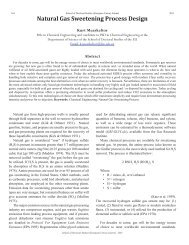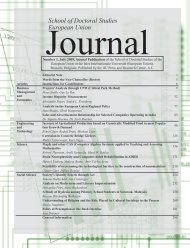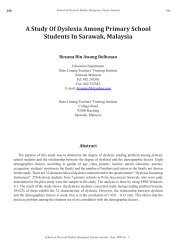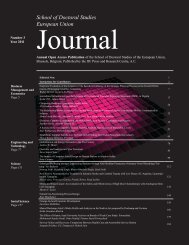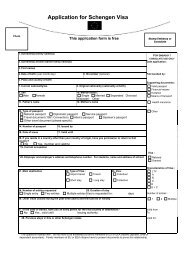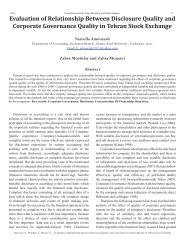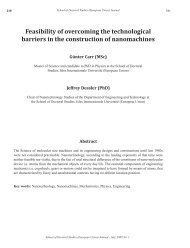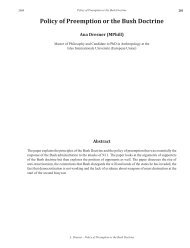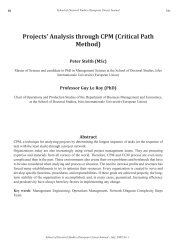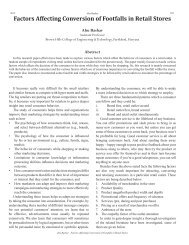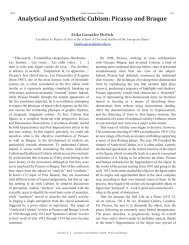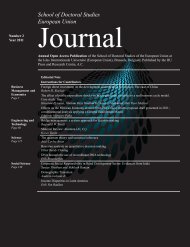Iiuedu.eu
Iiuedu.eu
Iiuedu.eu
You also want an ePaper? Increase the reach of your titles
YUMPU automatically turns print PDFs into web optimized ePapers that Google loves.
42 School of Doctoral Studies (European Union) Journal2011like telecommunication and electric supply are amonghindrances to online banking in Nigeria (Ezeoha 2005;Chiemeka et al., 2006). E-commerce challenges identifiedfrom the literature are classified as - technological,managerial, and business related and are summarised andpresented below.ChallengesTechnological challengesSecurityTable 2Research/literature(Koved et al. 2001; Czerniawska & Potter,1998; Alexander, 1998, Chaechter, 2002)Web site issues (Watson et al. 1999; Zhang &von Dran 2000;Lee 2001)Technology issuesincluding costs, software,infrastructureManagerial challengesPeople and organisationalissuesObtaining seniormanagement backingBusiness challenges(Hoffman et al. 1999; Abeyesekera et al. 1999;Rahul et al. 2001, Chaechter 2002)(Hoffman et al. 1999; Feeny 2000)(Feeny 2000)Customer service (Whinston et al. 1997; Alter, 1999; Lee 2001)Customers’ old habits (Hoffman et al. 1999; Schwartz, 1999)Legal issues(Hoffman et al. 1999; Lawrence et al. 1998; deSouza & von Wiese 2000), Chaechte, (2002)Adapted from Joze, Julie & Angela (2002)Prior Studies on Benefits And Challenges ofOnline BankingA previous study in Joze, Julie & Angela (2002) showedthat that the major benefits of e-commerce adoption notanticipated by the sector are business, efficiency, improvedimage, competitive advantage, increased automationof processes and increased business turnover. Also, thekey challenges identified for the sector are the costs ofthe technology, the lack of knowledge of e-commerce,managing the change, budgeting and issues associated withlinking back end systems. They did not consider securetransactions as a major challenge for the sector; in contrastthey were considered one of the success factors.Pohjola (2002) also showed that the contribution of th<strong>eu</strong>se of information communication technology to growth ofoutput in the Finnish market sector has increased from 0.3percentage points in early 1990s to 0.7 points in late 1990s.Similarly, research conducted in Estonia (Aarma andVensel, 2001), bank customers use bank office services onaverage 1.235 times per month, and wait in qu<strong>eu</strong>e in bankoffice on average for 0.134 hours. Simple calculation shows,that making payments via E-banking facilities (for instanc<strong>eu</strong>sing Internet bank) rather than in the bank offices createoverall economy savings in the amount of 0.93% of GDP(Average distance to nearest bank office is 4.14 km (Aarmaand Vensel, 2001), which takes approximately 0.21 hoursto travel. (BankAway, 2001; Gur_u, 2002) also consideredthe benefit from the customer point of view that there isa reduction in costs of accessing and using the bankingservices, increased comfort and timesaving - transactionscan be made 24 hours a day without requiring the physicalinteraction with the bank, quick and continuous access toinformation and corporations will have easier access toinformation as, they can check on multiple accounts at theclick of a button, better cash managementAccording to a survey by Booz, Allen & Hamilton(1996), an estimated cost providing the routine businessof a full service branch in USA is $1.07 per transaction,as compared to 54 cents for telephone banking, 27 centsfor ATM (Automatic Teller Machine) banking and 1.5cents for internet banking (Nathan 1999; Pyun et al.,2002). In Nordea Bank, Finland, one online transactioncosts the bank an average of just 11 cents, comparedto $1 for a transaction in the branch (Echikson, 2001).Average payment in internet bank or via direct debit cost4 times less, than payment in branch. On actual cost side(or cost side from the bank point of view), average directdebit payment cost 16 times less and payment in internetbank 7 times less, than payment in branch. Amrit (2007)however submitted that risk management, infrastructuredevelopment and policy formulation are the three majorchallenges of E-banking in Nepal. Technological problemslike connect break in service while withdrawing cash fromATM and poor mobile service. He also considered thatan adequate level of infrastructure and human capacitybuilding are required before banks adopt the full-fledgedE-banking. But Mohammad (2009) summarized the majorrisk of e-banking as operational risks (e.g. security risks,system design, implementation and maintenance risks);customer misuse of products and services risks; legal risks(e.g. without proper legal support, money laundering maybe influenced); strategic risks; reputation risks (e.g. in caseSchool of Doctoral Studies (European Union) Journal - 2011



